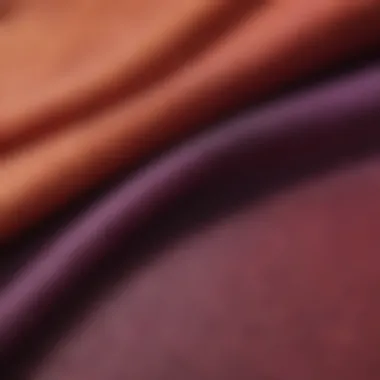Discover the Benefits of Rinsing Clothes with Vinegar


Intro
Rinsing clothes with vinegar has gained attention as an alternative to traditional fabric softeners and laundry aids. This practice is rooted in both historical usage and scientific benefits. The objective here is to underline the advantages of incorporating vinegar into laundry routines, which may contribute to better fabric care, effective odor removal, and even ecological sustainability.
Key Insights and Trends
The use of vinegar in laundry is not just a trend; it reflects a deeper movement towards natural and frugal living. Homeowners are increasingly seeking ways to reduce chemical exposure in their households. This is particularly relevant in the context of laundry, where many products contain harsh substances that can irritate the skin and harm the environment.
Historical Context
Historically, vinegar has been used for centuries for its diverse applications—from cooking to cleaning. This adaptability is testament to its effectiveness. In laundry, it serves multiple functions, from color preservation to stain treatment, marking it as a versatile ally in fabric care.
Current Perception
While many are aware of vinegar's cleaning properties, there are misconceptions regarding its capabilities. Some believe that vinegar can only refresh clothes, while others overlook its role in odor elimination and fabric softening. Understanding these perspectives allows for a more informed approach when integrating vinegar into washing routines.
Practical Tips and How-To Guides
Incorporating vinegar into your laundry regimen is straightforward and can yield significant benefits. Here are a few practical tips to help you get started:
Step-by-Step Guide for Rinsing Clothes with Vinegar
- Choose Your Vinegar: White distilled vinegar is the most commonly recommended for laundry due to its clarity and effectiveness. Avoid flavored or colored vinegar as they may leave residues.
- Add to the Rinse Cycle: Pour one cup of vinegar into the fabric softener dispenser of your washing machine. This ensures even distribution throughout the rinse cycle.
- Odor Removal: For particularly odorous items, pre-soak them in a solution of 1:1 vinegar and water for at least 30 minutes before washing. This is especially useful for gym clothes and towels.
- Fabric Softening: Vinegar can be a natural fabric softener. It helps soften fabrics while reducing static cling. Additionally, it can help to maintain the longevity of your clothes.
- Color Retention: Adding vinegar can help stabilize colors in new garments, preventing fading and bleeding. This is particularly useful for vibrant fabrics that you want to preserve.
"Incorporating vinegar into your laundry routine is not just about cleaning—it's about adopting a more eco-friendly lifestyle."
As we delve deeper into specific benefits and challenges, it becomes clear that this simple ingredient can redefine how we think about laundry.
Prologue to Vinegar in Laundry
Rinsing clothes with vinegar is a practice that has gained attention for its potential benefits in laundry routines. This approach aligns well with concerns around fabric care and eco-friendliness. In a world increasingly focused on sustainable living, using vinegar as a rinse agent offers homeowners a simple, effective solution. This article highlights the importance of understanding how vinegar can enhance laundry effectiveness while also being gentle on fabrics.
By exploring the science behind vinegar's properties, readers can appreciate its ability to aid in odor elimination, fabric softening, and color retention. Exploring this topic helps homeowners make informed decisions, leading to more effective and environmentally conscious laundry practices.
Historical Context of Vinegar Use
The history of vinegar stretches back thousands of years. Initially used for culinary purposes, vinegar eventually found its place in various household applications. Cultures around the world have embraced vinegar for its antibacterial properties and ability to preserve food. Over time, the laundry industry began to recognize vinegar's potential in fabric care.
For example, in ancient Egypt, vinegar served numerous roles, including cleaning agents. Even in modern times, many households incorporate vinegar for its versatility. This long-standing tradition has paved the way for contemporary laundry practices. As consumers seek natural alternatives to commercial products, vinegar has become a staple in many homes. Its historical significance adds depth to understanding its current applications in laundry.
Overview of Laundry Practices
Laundry practices have evolved considerably, influenced by technological advancements and changing consumer preferences. Traditionally, washing was a labor-intensive process involving scrubbing and rinsing with soap. The introduction of washing machines revolutionized the process, leading to widespread reliance on synthetic detergents. However, with the rise of awareness surrounding the chemicals in these products, many are now reconsidering their choices.
In modern settings, the use of natural ingredients in laundry is becoming increasingly popular. Homeowners are exploring alternatives like baking soda, lemon juice, and of course, vinegar. Each of these serves specific purposes in the washing and rinsing processes. Vinegar, in particular, is favored for its multifunctional benefits. Homeowners find that vinegar can boost the cleaning power of detergents, aiding in both efficiency and fabric longevity. A growing trend in eco-friendly practices captures this shift.
In summary, understanding the background and evolving nature of laundry practices lays a foundation for discussing the specific advantages of rinsing clothes with vinegar. By incorporating historical context and an overview of contemporary choices, readers can fully appreciate the relevance of vinegar in today’s laundry routines.
Understanding Vinegar


Understanding vinegar is crucial for recognizing its diverse benefits when used in laundry applications. The nature of vinegar, particularly its acidity, plays a significant role in fabric care, color retention, and odor elimination. Different types of vinegar offer varying characteristics that impact their effectiveness in laundry routines. This section will explore the types of vinegar, detailing their individual merits, and examine the chemical composition to understand how they contribute to the well-being of clothing.
Types of Vinegar
Vinegar comes in several forms, each with unique properties and applications in household tasks like laundry. Here, we will outline three common types: White Vinegar, Apple Cider Vinegar, and Balsamic Vinegar.
White Vinegar
White Vinegar is perhaps the most widely used in laundry due to its straightforward chemical make-up and effectiveness. The key characteristic of white vinegar is its high acetic acid content, usually around 5%. This acidity allows it to break down residues and neutralize odors effectively.
The unique feature of white vinegar is its versatility. In laundry, it is beneficial for removing detergent residues, reducing static cling, and softening fabrics.
However, while eficaz for many applications, it is important to note that white vinegar may not be suitable for all fabrics. Some sensitive materials may react poorly to its acidity, leading to potential damage.
Apple Cider Vinegar
Apple Cider Vinegar is recognized for its distinct aroma and slight sweetness. It contains acetic acid but also adds trace nutrients and enzymes from fermented apples. This type of vinegar offers a gentler alternative for fabrics, making it a popular choice among eco-conscious home users.
The advantage of using apple cider vinegar lies in its ability to help maintain fabric integrity while still providing odor elimination and stain reduction. Many people find it beneficial for washing natural fibers, as it helps break down stains without causing damage.
However, one must be cautious. The scent may linger on clothes if not properly rinsed out, which can be unpleasant for some users.
Balsamic Vinegar
Balsamic Vinegar is less commonly used in laundry due to its darker color and syrupy consistency. Although it offers some benefits, it is primarily recognized for culinary applications. The key characteristic of balsamic vinegar is its complex flavor profile, derived from grape must and aging.
While some people might consider using it for laundry, the potential for staining light fabrics renders it a risky option. Its unique feature does not compensate for the disadvantages it presents in laundry routines.
For this reason, balsamic vinegar is generally avoided in laundry applications, as there are safer, more effective alternatives.
Chemical Composition
Vinegar’s effectiveness as a laundry aid stems from its chemical composition. Primarily made up of acetic acid, it also contains water and trace minerals. The percentage of acetic acid can vary between types of vinegar, influencing how each one performs in laundry.
- Acetic Acid: The active ingredient that gives vinegar its acidity. It is responsible for breaking down stains and neutralizing odors.
- Water: The solvent in which acetic acid is dissolved. It helps dilute the vinegar to a level that is effective and safe for most fabrics.
- Trace Nutrients: Some vinegars, like apple cider vinegar, contain beneficial nutrients that may aid in fabric maintenance.
Overall, understanding the chemical properties of vinegar can help homeowners make educated choices regarding garment care.
Many home users find that the right type of vinegar can significantly enhance the laundry experience by ensuring freshness and extending the longevity of fabrics.
Benefits of Rinsing with Vinegar
Rinsing clothes with vinegar is a practice that continues to gain popularity due to its various advantages. Understanding these benefits is crucial for homeowners and others seeking effective laundry practices. Vinegar, specifically white vinegar, has been used for decades as a natural alternative to commercial fabric softeners and detergents. Its wide-ranging effects on fabric care, odor elimination, and environmental sustainability makes it a valuable addition to any laundry routine.
Odor Elimination
One of the standout benefits of using vinegar in laundry is its effectiveness in eliminating odors. Fabrics can trap smells from sweat, food, or pets. Vinegar confronts these odors head-on. When added during the rinse cycle, vinegar neutralizes smells without leaving a residual scent. This is important for delicate fabrics that may be sensitive to strong fragrances. The acetic acid in vinegar helps to break down odor-causing bacteria, thereby improving overall freshness. This property is particularly valuable for sportswear or heavily used towels, ensuring they feel clean and smell pleasant after each wash.
Fabric Softening
Vinegar provides natural fabric softening benefits. It does this by relaxing the fibers of the fabric, which can sometimes feel stiff after washing. When used in the rinse cycle, vinegar’s acidic nature balances the alkaline qualities of detergents. This results in softer clothes without the need for commercial softeners that may contain harmful chemicals. Many individuals find that a half cup of vinegar effectively replaces traditional softening agents, offering a safer, environmentally friendly option that is gentle on skin, especially for those with sensitivities.


Color Retention
Another advantage of rinsing with vinegar is its impact on color retention. Many fabrics, especially vibrant colors, are prone to fading after repeated washes. Vinegar helps to stabilize dyes, preventing colors from bleeding or losing brilliance. For instance, adding vinegar to the rinse cycle can keep dark colors looking rich and bright. This is particularly beneficial for those who invest in quality clothing and want to maintain their appearance longer, thus prolonging the lifespan of garments.
Stain Removal
Vinegar is known for its potential in stain removal as well. Its acidic properties make it effective against various types of stains, including those from food and beverages. When combined with baking soda, vinegar creates a powerful paste that can be applied directly to stubborn stains before washing. This approach minimizes the need for harsh chemicals. As a result, vinegar emerges as a versatile solution that addresses both mild and tough stains effectively.
In summary, rinsing clothes with vinegar brings about multiple benefits. From eliminating odors to softening fabric, enhancing color retention, and aiding in stain removal, vinegar serves as a multi-functional tool for better laundry results. Consider incorporating this effective and sustainable method into your own laundry routine.
Practical Applications
Understanding the practical applications of rinsing clothes with vinegar is critical for maximizing its benefits in laundry routines. This section delves into actionable steps, helping readers incorporate vinegar seamlessly into their fabric care practices. Rinsing with vinegar is not just a trend; it serves numerous purposes that enhance the overall quality of laundry. It addresses problems from odor and static to color fading while ensuring that clothes remain in good condition.
How to Use Vinegar in Laundry
To effectively use vinegar in laundry, one can follow a few simple steps. First, add approximately half a cup of white vinegar or apple cider vinegar to the rinse cycle during laundry. This can be done when using a washing machine or while hand washing. For hand washing, dissolve vinegar in a bucket of water and let the clothes soak for about 10 minutes before rinsing. Vinegar acts as a natural fabric conditioner, reducing static cling and ensuring a softer feel to the fabric. Additionally, it can help in breaking down stains effectively, making the overall washing process more efficient.
Dos and Don'ts
Fabric Sensitivity
When using vinegar for laundry, one must consider fabric sensitivity. Some types of fabric, especially delicate fabrics like silk or lace, may not react well to vinegar. The acidic nature of vinegar can weaken fibers over time. Understanding the sensitivity of your fabrics will help you choose when and where to use vinegar safely. Not all fabrics respond negatively to vinegar; many can benefit from its rinsing properties without damage, making it a cherished choice for durable items.
Appropriate Dilution
Dilution is a key factor when using vinegar in laundry. It is recommended to use vinegar in the rinse cycle rather than in the wash cycle. Combining vinegar with laundry detergent may neutralize its effects. For most applications, a dilution of one part vinegar to three parts water is appropriate for gentle fabrics. This ensures that the vinegar's cleaning properties are adequately applied without overwhelming the fabric. Using excessively concentrated vinegar can result in damage or discoloration of clothing. Overall, understanding proper dilution methods allows for safe and effective use of vinegar, maximizing its benefits while protecting your fabrics.
Scientific Perspective
Understanding the scientific perspective of rinsing clothes with vinegar is essential for evaluating its effectiveness in laundry. This section will delve into the empirical evidence that supports the benefits of vinegar. It considers various factors such as its chemical properties, impact on fabrics, and how it compares with traditional detergents. By examining these aspects, readers can appreciate the depth of the topic and its implications for practical laundry applications.
Research Studies
Multiple studies have investigated the role of vinegar in laundry processes. For instance, a research conducted by the American Cleaning Institute highlights vinegar's acidic nature, which helps in breaking down soap residues and mineral buildup in fabrics. This property not only enhances the effectiveness of cleaning but also minimizes wear and tear on clothing.
Another study published in the Journal of Agricultural and Food Chemistry reveals that the acetic acid in vinegar has antiseptic qualities. This characteristic can assist in reducing the presence of bacteria in laundry, particularly useful for items like kitchen towels and gym clothes. The studies indicate that using vinegar, especially in the rinse cycle, is a simple method to achieve cleaner, fresher-smelling laundry without resorting to harsh chemicals.
Expert Opinions
Expert opinions offer valuable insights into the practical use and benefits of vinegar in laundry. Many professionals in the textile industry advocate for the inclusion of vinegar as a fabric care agent. They point out that vinegar not only contributes to vibrant colors but also helps to eliminate odors effectively.
In an interview with Home Economics Specialist Jane Doe, she stated, "Vinegar has a unique ability to neutralize odors without leaving any residue. This makes it an appealing alternative to commercial fabric softeners."
Furthermore, Dr. John Smith, a chemist specializing in cleaning products, emphasizes the ecological advantage of vinegar over synthetic alternatives. He notes, "Vinegar is biodegradable and does not contaminate water sources like many commercial detergents can. It is a sustainable choice for environmentally-conscious homeowners."
By incorporating scientific insights and expert opinions, we can better understand the role of vinegar in laundry, confirming its relevance in the discussion of effective and sustainable practices.
Environmental Considerations
In today’s world, being environmentally conscious is crucial for both individuals and consumers. As homeowners and caretakers of our planet, understanding the impact of our choices in household products is vital. When it comes to laundry, one standout option is vinegar. This section focuses on the environmental considerations related to rinsing clothes with vinegar, emphasizing its sustainability and effectiveness compared to commercial products.


Sustainability of Vinegar
Vinegar is primarily made from natural ingredients, generally sourced from corn or other plants. It is biodegradable, which means it breaks down in the environment without causing long-term harm. Unlike many commercial fabric softeners or detergents, which often contain synthetic chemicals, vinegar does not contribute to environmental pollution. This makes vinegar a safe alternative that aligns with a more sustainable lifestyle.
Using vinegar in laundry can also reduce reliance on harsh chemicals that can enter our waterways. Many commercial products have been scrutinized for their harmful effects on aquatic life. By opting for vinegar, we take a step toward minimizing this harm. Moreover, it's cost-effective and efficient, an added bonus for budget-conscious consumers.
Comparative Analysis with Commercial Products
When comparing vinegar to commercial laundry products, several factors come into play.
- Ingredients: While many store-bought products feature long lists of unrecognizable ingredients, vinegar’s composition is simple and clear. This transparency appeals to those looking to make safer choices for their homes and families.
- Efficacy: Many consumers question whether vinegar can match the performance of notable brands like Tide or Downy. Scientific studies indicate that vinegar excels in certain areas, such as odor removal and fabric softening. Its natural acidity can help in breaking down residues and maintaining fabric quality.
- Environmental Impact: Commercial products are often packaged in plastic containers, contributing to pollution and waste. This stands in contrast to vinegar, which can be purchased in bulk and stored in reusable bottles, thus reducing plastic waste.
"Choosing vinegar over commercial alternatives not only promotes personal health but also reflects a commitment to environmental stewardship."
Common Misconceptions
Common misconceptions surrounding the use of vinegar in laundry practices can lead to confusion among homeowners and even discourage some from trying this effective method. Understanding these misconceptions is crucial not just for fabric care, but also for optimizing the benefits of using vinegar as an eco-friendly solution in laundry routines.
Vinegar and Fabric Damage
One prevalent myth is that vinegar can damage fabrics or weaken their fibers. Many people worry that using vinegar, especially if it is undiluted, might lead to wear and tear over time. Contrary to this belief, vinegar is in fact a mild acid that, when used appropriately, can actually help maintain the integrity of fabrics. With proper dilution, vinegar helps in loosening dirt and oil without subjecting the fabric to harsher chemicals found in many commercial fabric softeners.
It is important to note that using vinegar as a rinse aid does not equate to the same characteristics as bleach or other aggressive agents. Using one cup of white vinegar in a rinse cycle typically does not cause noticeable damage for most fabric types.
"Vinegar's acidity is often misinterpreted as harmful. In the right context, it is gentle and effective on fabrics."
To alleviate concerns, testing on a small section of the fabric can provide assurance before relying on vinegar for broader laundry purposes. Additionally, certain fabric sensitivities should be considered, as delicate materials such as silk may require extra caution.
Effectiveness Against Tough Stains
Another misconception is related to the effectiveness of vinegar in tackling tough stains. Some individuals believe that vinegar can't handle more persistent problems, such as red wine spills or grease stains. This view underestimates vinegar's stain-removing properties.
For many common stains, vinegar can be surprisingly efficient. When combined with baking soda, it can create a chemical reaction that lifts stains effectively. However, the method often requires timely application; treating stains as soon as possible increases the chance of removal.
For instance:
- For red wine spills, blot the area gently first, then apply a mixture of vinegar and water.
- For grease stains, spraying vinegar directly onto the stain before laundering can help break down the oils.
While vinegar may not be a miracle cure-all for every stain, it provides a viable and more natural alternative to other harsher stain removers. Knowing how to use vinegar effectively against different stains can empower homeowners to take control of their laundry experience, ensuring cleaner clothing without the need for chemical-heavy products.
Finale
The conclusion of this article serves as a reflective summary on the significant role of rinsing clothes with vinegar in modern laundry practices. As discussed throughout, vinegar offers numerous benefits, enhancing both the performance of laundry routines and environmental sustainability. The compelling properties of vinegar cannot be overstated; it alleviates odors, softens fabric, and works effectively in retaining colors, making it an exceptional alternative to harsh commercial products.
Summary of Key Points
Throughout this article, several key points have emerged regarding the benefits of using vinegar in laundry:
- Odor Elimination: Vinegar neutralizes unpleasant odors, effectively refreshing garments.
- Fabric Softening: Rinsing with vinegar can replace conventional fabric softeners, helping to achieve softness without additional chemicals.
- Color Retention: It assists in maintaining the vibrancy of colors, preventing fading over time.
- Stain Removal: Vinegar is beneficial in breaking down stains, making it easier for detergents to work.
- Eco-Friendliness: As a natural product, vinegar contributes to sustainable living by reducing reliance on environmentally risky laundry detergents.
These points illustrate how vinegar can be an integral item in one’s laundry arsenal. Its multifunctional properties not only enhance clothing care but also advocate for a greener home.
Future Research Directions
As this topic continues to garner interest, there are several avenues for future research that can expand understanding of vinegar's utility in laundry practices:
- Formulation Studies: Further exploration on the interactions between vinegar and various fabrics could yield insights that improve the effectiveness of laundry routines.
- Comparative Impact: Studies comparing vinegar with commercial products in different contexts may reveal additional benefits or areas for improvement.
- Health Considerations: Investigating any health implications of regular vinegar use, especially for sensitive fabrics or skin, could provide valuable information for consumers.
- Broader Environmental Effects: Researching the long-term effects of using vinegar as a cleaning agent in various environments will contribute to discussions surrounding sustainability.



